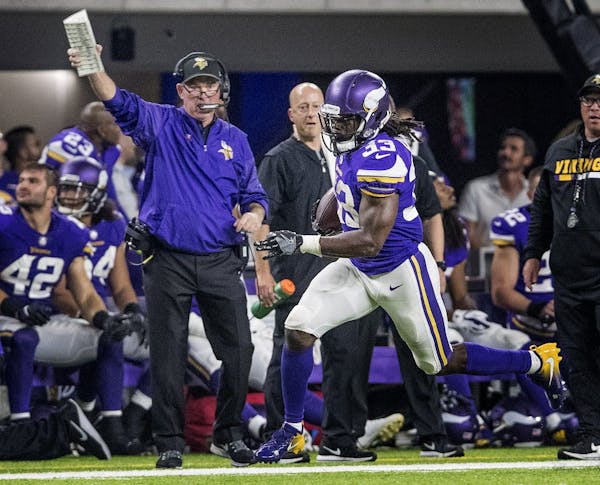Minnesota Vikings quarterback Sam Bradford (8) greets teammates before an NFL football game against the New Orleans Saints, Monday, Sept. 11, 2017, in Minneapolis. (AP Photo/Bruce Kluckhohn)
The morning after each Vikings game, beat writer Ben Goessling dives in for a deeper look at a key aspect of how the Vikings played, and what it means for the team going forward:
On their first scoring drive on Monday night, the Vikings used four different personnel groups. They trotted out a four-receiver set — seen on only seven snaps in the 2 1/2 years Norv Turner ran the offense — and followed it with a two-back, three-receiver set on Jerick McKinnon's 10-yard run.
In the second quarter, the Vikings had an empty backfield, with four receivers and a tight end, and they flexed Jerick McKinnon out to wide receiver to create an empty backfield in the third quarter. A hurry-up offense facilitated Sam Bradford's first touchdown to Stefon Diggs, who was wide open in the end zone behind a frazzled Saints defense.
Though it's only one game, this doesn't seem to be the Vikings' offense of the past three years, which relied on a relatively static set of personnel groups and often seemed to be a collection of mismatched parts. The Vikings of Week 1 threw jabs early, and haymakers later on, from a variety of angles, using five different receivers, four different running backs and three different tight ends at various points in the game. Dalvin Cook — who broke Adrian Peterson's team record for the most rushing yards in the first game of his career — caught three passes out of the backfield, and McKinnon added three more for 32 yards. The Vikings seemed, at least in Week 1, harder to peg than perhaps they'd been in the past.
"I thought we were pretty multiple in our looks tonight, going spread, going '22' [personnel, with two running backs and two tight ends], going '21'," Bradford said. "So hopefully that's something we can continue to do."
It certainly didn't hurt that Bradford had as clean of a pocket as he did, getting pressured on just six of his 34 dropbacks, according to Pro Football Focus. He had a perfect passer rating of 158.3 on throws of 20 yards or more, hitting all five of his attempts for 130 yards and a touchdown.
The Vikings, though, also got some explosive plays from their running game late in the night, when Cook started the fourth quarter with a 32-yard run and later added another 33-yarder. After the team had just six runs of 20 yards or more all of last season, it's already a third of the way to last year's output.
The Saints have eight new starters on defense, and the Vikings had the good fortune of feasting on a unit that often looked disheveled on Monday night. But milquetoast defenses didn't always guarantee success for the Vikings last year, and they were able to establish a foundation in their season-opener.
That foundation, it appears, is going to look markedly different than what the Vikings have done in the past.
"I know we didn't play great as an offense during the preseason games. We've seen what we're capable of doing," Bradford said. "We talked a lot about playing by rule and making sure we were on the same page. Those guys up front did a good job all week just making sure they were prepared. I think it showed tonight. They played fast, they played confident, we were in and out of the huddle, the tempo was great tonight, we were getting to the line early. I think we put pressure on them."
Will Power denies participating in Penske cheating scandal. Silence from Josef Newgarden
Cubs reliever Luke Little forced to change his glove because of white in American flag patch
Kentucky appeals court denies Bob Baffert-trained Arkansas Derby winner Muth to enter Kentucky Derby

